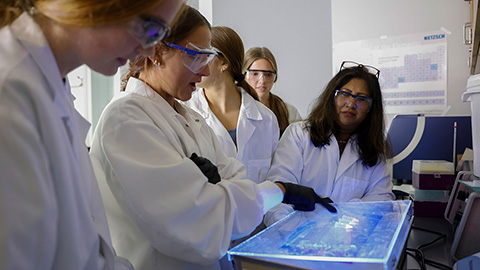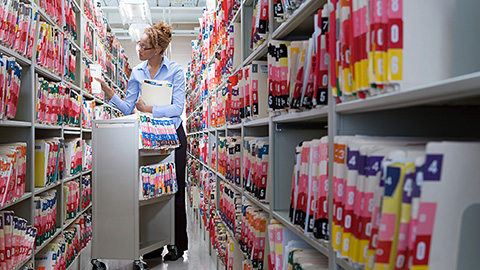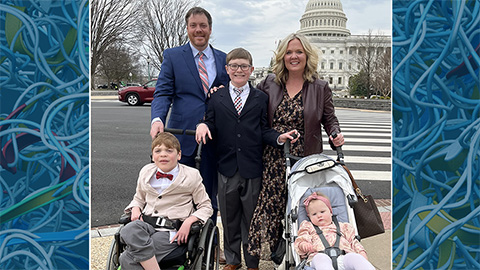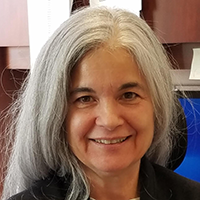With challenges come opportunities
It is a special honor to begin my term as president of the American Society for Biochemistry and Molecular Biology. The ASBMB is very dear to me.

I began my scientific career as an undergraduate obtaining summer research experience in a biochemistry lab and have been hooked ever since. My doctoral thesis research at Rice University focused on biophysical and kinetic analysis of electron transport in cytochrome oxidase, which led to a first-author paper in the Journal of Biological Chemistry. Publishing that first paper in JBC and receiving those reprints with my name in print for the first time was truly exciting!
My research interests have evolved over the years into the study of proteases and protease-activated signaling pathways that affect tumor metastasis, inflammation and vascular biology. My lab studies several inflammatory mechanisms that promote blood clotting and the resolution of venous thrombosis as well as proteolytic signaling pathways used by ovarian cancers to facilitate tumor dissemination and spread.
I have continued my association with the society by serving on the Publications Committee and the Finance Committee and later as treasurer. This has allowed me to see the ASBMB grow and develop into a robust organization that strives to meet the needs of all of its members.
Thanks to the ASBMB scientific leadership, the excellent staff and the many dedicated committee volunteers, the society is in great shape. This is particularly important in the present COVID-19 environment and given the novel challenges we, as scientists, are facing. Universities have closed, and much research has been halted this year. We all cautiously are working out safe conditions for reopening and continuing laboratory research. A new paradigm is emerging at universities — virus testing systems are being put in place, and there are changes to the formal academic processes, which will undoubtedly have lasting effects. Many scientific and teaching activities are moving fully or partially online, with strict guidelines for social distancing and mask wearing.
This is unchartered territory. It has impacted our younger scientists significantly: graduate students aiming to complete their dissertations, postdoctoral fellows looking for jobs and junior faculty trying to build networks and collaborations. The ASBMB is committed to providing career-development resources for these groups, including its recently revamped online career center, the Art of Science Communication course and virtual presentation opportunities. (See asbmb.org/career-resources for those and more.)
Interview with Toni Antalis
Read ASBMB Today staff writer Laurel Oldach’s interview with Toni Antalis.There will be challenges in maintaining financial support for discovery research with increasingly competitive funds and uncertain economic conditions. The ASBMB serves as a defender of science and influencer of government policy on issues of concern to ASBMB members. The society responds rapidly to policy proposals and changes and stands firmly against attempts to politicize science and science funding. (See asbmb.org/advocacy for recent policy statements and to learn how to participate in advocacy efforts.)
Importantly, we must ensure social justice, fairness and civility for all and in all that we do.
Our immediate past president, Jerry Hart, did a tremendous job guiding the society through some major challenges over the past two years and deserves a special thanks. Importantly, he led the careful and consultative effort by the society to make all three ASBMB journals — JBC, Molecular & Cellular Proteomics, and the Journal of Lipid Research — fully open access in 2021. This means that the final versions of the high-quality articles will be immediately available to everyone around the world, thus reducing barriers to scientific knowledge and accelerating scientific discoveries. A long history of sound financial stewardship by the society has enabled this to happen in an affordable way for authors — society members and nonmembers alike.
We are truly indebted to Herbert Tabor, who served at the helm of JBC for 40 years and who strongly supported and helped to mold the community of biochemists and molecular biologists that we have today. JBC Editor-in-Chief Lila Gierasch, MCP Editor-in-Chief Al Burlingame and JLR co-Editors-in-Chief Nicholas Davidson and Kerry-Anne Rye are doing wonderful jobs of overseeing their publications with the support of excellent associate editors and editorial board members, all of whom deserve our thanks for their dedicated service to the society and the scientific community.
With challenges come opportunities. This is an exciting time to be a molecular and biological scientist. Advances in genomics, imaging, bioengineering, CRISPR technologies, cryogenic electron microscopy, vaccine development and computational learning are advancing our understanding of biological systems significantly.
The ASBMB is devoted to advancing the science of biochemistry and molecular biology and serving the needs of the scientific community. I encourage you to visit the ASBMB website (asbmb.org) to learn about all of the resources and wonderful activities that the society provides and the impact on our scientific community.
You too can join this effort and make a difference. Let us know what will make us even better. We welcome your thoughts.
Enjoy reading ASBMB Today?
Become a member to receive the print edition four times a year and the digital edition monthly.
Learn moreGet the latest from ASBMB Today
Enter your email address, and we’ll send you a weekly email with recent articles, interviews and more.
Latest in Opinions
Opinions highlights or most popular articles

Debugging my code and teaching with ChatGPT
AI tools like ChatGPT have changed the way an assistant professor teaches and does research. But, he asserts that real growth still comes from struggle, and educators must help students use AI wisely — as scaffolds, not shortcuts.

AI in the lab: The power of smarter questions
An assistant professor discusses AI's evolution from a buzzword to a trusted research partner. It helps streamline reviews, troubleshoot code, save time and spark ideas, but its success relies on combining AI with expertise and critical thinking.

How AlphaFold transformed my classroom into a research lab
A high school science teacher reflects on how AI-integrated technologies help her students ponder realistic research questions with hands-on learning.

Writing with AI turns chaos into clarity
Associate professor shares how generative AI, used as a creative whiteboard, helps scientists refine ideas, structure complexity and sharpen clarity — transforming the messy process of discovery into compelling science writing.

Teaching AI to listen
A computational medicine graduate student reflects on building natural language processing tools that extract meaning from messy clinical notes — transforming how we identify genetic risk while redefining what it means to listen in science.

What’s in a diagnosis?
When Jessica Foglio’s son Ben was first diagnosed with cerebral palsy, the label didn’t feel right. Whole exome sequencing revealed a rare disorder called Salla disease. Now Jessica is building community and driving research for answers.

